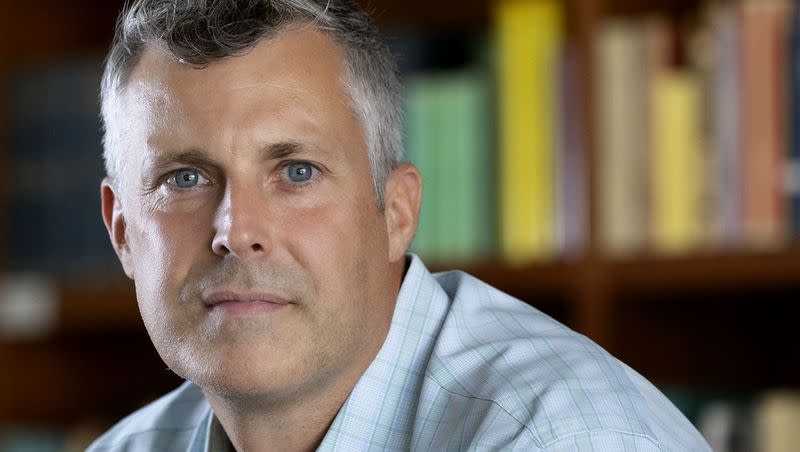Utah professor says genetics, personalized medicine aren’t a ‘magic bullet’ for many diseases

Major scientific breakthroughs like mapping the human genome have given researchers the ability to isolate specific genetic markers that can increase one’s risk for developing certain diseases.
The technology has been followed by an explosion of interest and hype about so-called precision medicine, where treatments can be developed specifically to respond to a person’s genetic makeup and — in theory — provide more effective results when treating diseases like cancers, Alzheimer’s disease and Parkinson’s disease, among others.
But much of that hype doesn’t factor in many of the economic and scientific hurdles that exist, and it also ignores environmental factors that are known to contribute to those diseases, according to University of Utah professor James Tabery.
Tabery teaches at the U.’s Department of Philosophy and is a member of the Center for Health Ethics, Arts and Humanities at the university. He’s also the author of the recent book ”Tyranny of the Gene: Personalized Medicine and Its Threat to Public Health,” in which he charts the enormous investment in gene-based research in recent decades, to the detriment of pursuing more effective health outcomes.
The subject is a personal one for Tabery. The book opens with the story of his father’s diagnosis of lung cancer in 2011, and the subsequent months of treatment using a drug called erlotinib, for which his father’s cancer was a genetic match.
The treatment initially helped shrink the tumors, giving his father a chance to leave the hospital and continue doing the things he loved, but the cancer returned the next year, and he passed away a little over a year after the original diagnosis.
While it’s impossible to quantify how much extra time erlotinib afforded his father, who lived 13 months after receiving an eight-month prognosis, the drug likely helped extend his life.
“I and the rest of my family were really grateful for that,” Tabery told KSL.com earlier this month.
But as Tabery learned more about precision medicine treatments, he learned that his father’s experience wasn’t indicative of all patients, some of whom burned through their personal wealth on costly drugs that did little to improve their health outcomes in the long term.
What is precision medicine?
Precision medicine, also known as personalized medicine, uses “molecular-genetic information about patients to deliver the right treatment, to the right patient, at the right time,” Tabery wrote in a recent New York Times piece adapted from his book. Whereas traditional drugs such as ibuprofen or Benadryl are developed to be effective for the widest possible audience, precision medicines segment patients based on genetic markers, promising niche treatments intended to be most effective for a small subset of the population.
Genetic-based drugs have changed the game when it comes to a handful of rare diseases. “Tyranny of the Gene” describes how the approval of imatinib in 2001 turned chronic myelogenous leukemia, a rare blood cancer, from a disease with a life expectancy of less than five years to a chronic condition that could be managed similarly to Type 2 diabetes.
While precision medicine has its success stories, Tabery argues that many diseases are too complex to isolate a handful of genes that can be targeted, meaning most treatments temporarily relieve patients, but at great financial cost.
Unlike “blockbuster” drugs like ibuprofen, precision medicines only work for a small percentage of patients, which drives up the cost to each because of the low demand.
Erlotinib, which Tabery’s father took, is on the cheap end of the spectrum at $5,000 a month, but some can cost as much as $50,000, he said. Tabery said his family was lucky to have good health insurance, but families who don’t — or who lose health insurance because the provider is sick and can no longer work — are often on the hook and can quickly wipe out any personal wealth trying to keep a loved one alive.
“People are so desperate, and I think that’s one of the real selling points of this whole approach to medicine,” he said. “Everybody knows somebody who’d died of cancer, and to be able to say, ‘This is the way to the cure,’ or, ‘This is a kind of magic bullet,’ it’s hard not to get excited about that. I think that’s one of the things that makes it so hard to combat the hype about this is because people want it to be true.”
Environmental factors and disease
While genetics can play a role in which diseases a person is more at risk of developing, environmental factors like pollution can also increase risk in ways that genomics can’t fully account for. That’s evident in Salt Lake City, Tabery said, where residents on the west side have higher risk levels for cancer and lower life expectancies compared to residents on the east side.
The same is true in cities across the U.S., where minority and low-income populations face increased risk of disease.

